When we’re searching for dinner answers that combine convenience with incredible flavor, beef cubes consistently deliver the perfect answer. These versatile protein powerhouses transform ordinary weeknight meals into restaurant-quality experiences that’ll have your family asking for seconds.
We’ve mastered the art of turning tender beef cubes into show-stopping dinners that work with any schedule. Whether you’re craving a hearty beef stew that simmers while you tackle your day or a quick stir-fry that’s ready in minutes, these recipes prove that impressive doesn’t have to mean complicated.
The beauty of cooking with beef cubes lies in their incredible adaptability – they absorb flavors beautifully and cook evenly every time. From Mediterranean-inspired dishes to classic comfort food favorites, we’ll show you how to unlock the full potential of this affordable cut and create memorable meals that won’t break your budget or your timeline.
Classic Beef Stew With Tender Cubes
We’ll transform basic beef cubes into a rich, comforting stew that rivals any restaurant version. This timeless recipe builds on the convenience we’ve already established with beef cubes while creating deeper, more complex flavors.
Choosing the Right Cut of Beef
Chuck roast provides the best balance of flavor and tenderness for our beef cube stew. We recommend selecting meat with visible marbling throughout, as these fat streaks break down during cooking to create that melt-in-your-mouth texture.
Blade roast offers another excellent option, containing more connective tissue that transforms into gelatin during slow cooking. We’ve found this cut produces an incredibly rich broth that coats each spoonful perfectly.
Bottom round works well for budget-conscious cooks, though it requires longer cooking times to achieve optimal tenderness. We suggest cutting these tougher cuts into smaller 1-inch cubes to reduce cooking time while maintaining the hearty texture that makes beef stew so satisfying.
Essential Vegetables and Seasonings
Root vegetables form the foundation of our classic beef stew recipe. We layer carrots, potatoes, and onions to create natural sweetness that balances the savory beef flavors. Celery adds a subtle crunch and aromatic depth that enhances the overall taste profile.
Fresh herbs elevate the dish from ordinary to extraordinary. We combine thyme, rosemary, and bay leaves to create an aromatic bouquet that infuses throughout the cooking process. Garlic cloves provide pungent warmth that complements the beef’s richness.
Tomato paste intensifies the stew’s color and adds umami depth. We sauté this ingredient before adding liquids to develop its concentrated flavor. Red wine or beef stock creates the liquid base, with each option contributing distinct flavor notes to our final dish.
Slow Cooking Techniques for Maximum Flavor
Searing the beef cubes first creates a caramelized crust that locks in juices and develops complex flavors. We heat oil in our Dutch oven until it shimmers, then brown each cube on all sides without overcrowding the pan.
Layering ingredients at exact intervals ensures everything cooks evenly. We start with aromatics like onions and garlic, then add harder vegetables like carrots and potatoes before introducing the beef back into the pot.
Low and slow cooking at 325°F transforms tough connective tissues into tender, flavorful meat. We maintain a gentle simmer for 2-3 hours, checking periodically to ensure the liquid doesn’t evaporate completely. This method allows flavors to meld while beef cubes become fork-tender without falling apart.
Hearty Beef Curry With Aromatic Spices
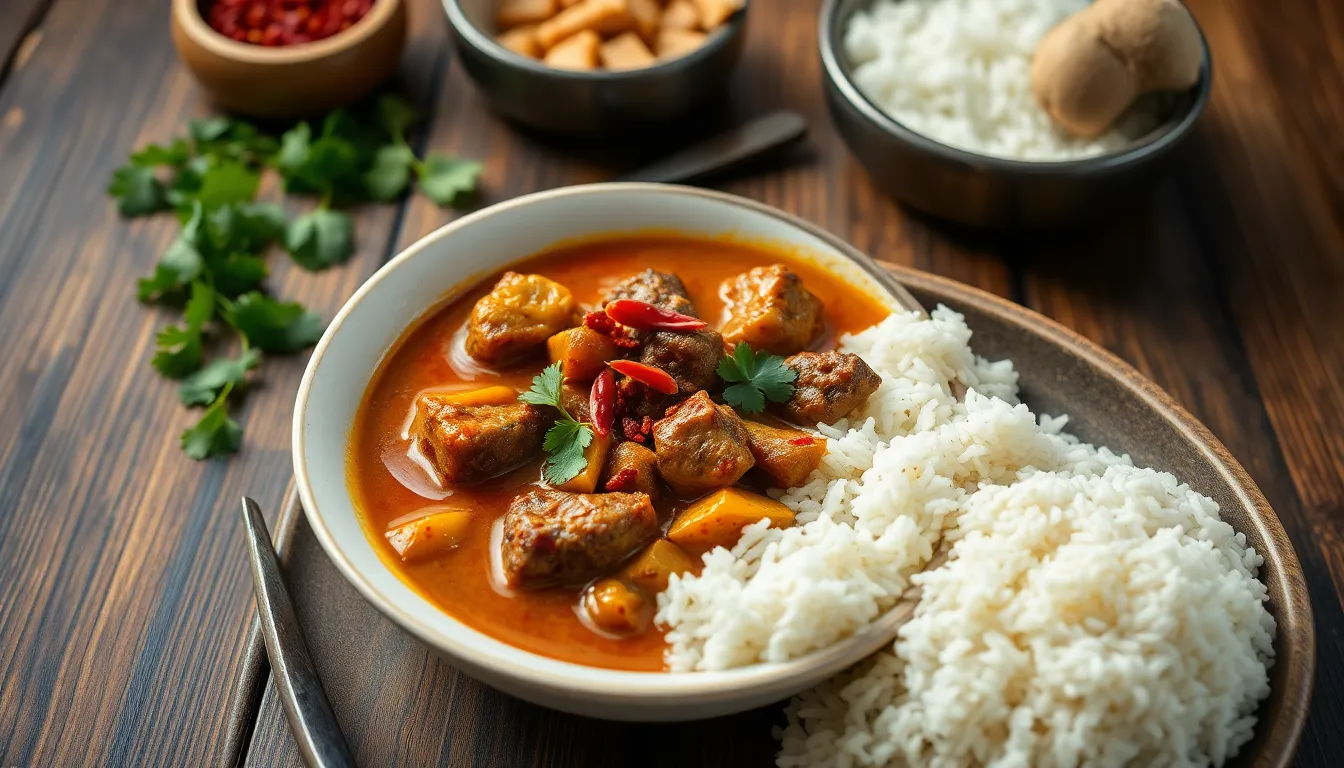
Building on our expertise with comforting beef cube dinners, we’re excited to share how transforming these versatile pieces into an aromatic curry creates an entirely new flavor experience that rivals any restaurant dish.
Building Layers of Curry Flavor
Marinating beef cubes in a blend of turmeric, chili powder, garam masala, and ginger infuses deep flavor into every piece of meat before cooking even begins. Starting with whole spices like cumin seeds, cinnamon, and bay leaves sautéed in hot oil releases their essential oils and creates the aromatic foundation for our curry.
Cooking onions, garlic, and tomatoes until soft provides the rich base that supports all other flavors in the dish. Adding ground spices directly to the beef cubes and cooking them briefly builds complexity that can’t be achieved by simply stirring spices into liquid.
Slow cooking the curry in a heavy bottom pot allows flavors to meld beautifully while ensuring our beef cubes become fork tender through gentle, extended heat. This patient approach transforms simple ingredients into a deeply satisfying meal that showcases the natural richness of beef.
Coconut Milk vs. Tomato-Based Curries
Tomato based curries dominate Indian style recipes and create tangy, rich sauces that complement beef’s hearty flavor perfectly. Softened tomatoes combined with our spice mixture deliver bold, acidic notes that brighten the entire dish.
Coconut milk based curries offer a completely different experience with their creamy, slightly sweet profile that balances spices like curry powder, cumin, and soy sauce. This one pot coconut curry beef stew style adds smooth texture and richness while reducing acidity compared to tomato versions.
Including vegetables like potatoes and carrots in coconut milk curries creates additional layers of flavor and nutrition. These additions simmer until tender in the curry, absorbing the creamy sauce while contributing their own natural sweetness to the final dish.
Serving Suggestions and Side Dishes
Plain basmani rice serves as the ideal accompaniment for both curry styles, providing a neutral base that soaks up every drop of flavorful sauce. Indian breads such as naan or chapati offer another excellent option for capturing and enjoying the rich curry.
Fresh cilantro, red chili flakes, and white sesame seeds make perfect garnishes for coconut milk curries, adding brightness and gentle heat that enhances the overall experience. These simple additions provide textural contrast and visual appeal to our finished dish.
Balancing the spices with simple vegetable stir fries or cooling raita creates a complete meal that satisfies different taste preferences at the table. These complementary sides ensure everyone can customize their curry experience while enjoying the star attraction of tender, flavorful beef cubes.
Savory Beef Stroganoff With Mushrooms
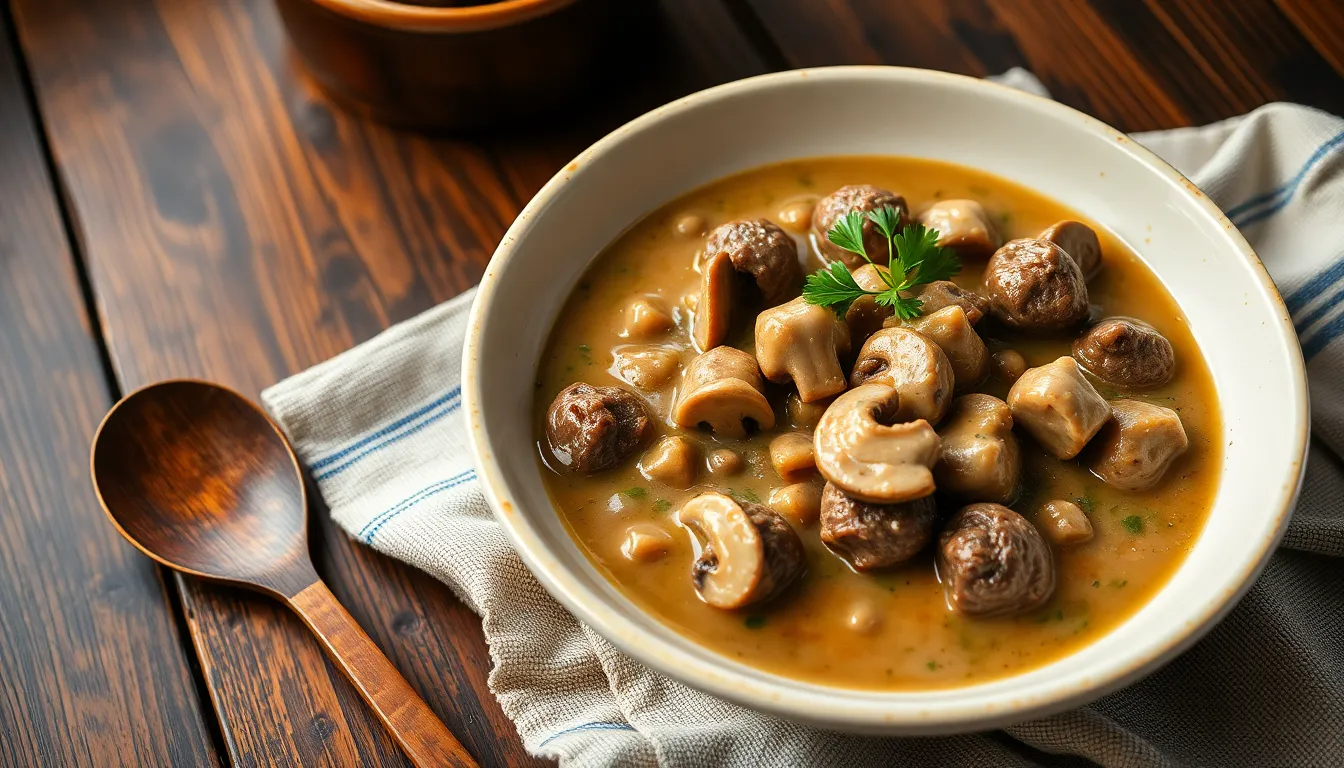
Building on our exploration of comforting beef cube dinners, we’ll transform simple beef cubes into the ultimate comfort food classic that rivals any restaurant dish. This savory stroganoff combines tender chunks of beef with earthy mushrooms to create a rich, satisfying meal that’s perfect for weeknight dinners.
Creating the Perfect Creamy Sauce
We start by searing our beef cubes quickly over high heat to prevent steaming and ensure maximum tenderness. Ribeye offers exceptional fat content and flavor, while sirloin and scotch fillet provide affordable yet tender alternatives for budget conscious cooks. Chuck roast works beautifully for those who prefer to slow cook their stroganoff for deeper flavor development.
Next, we sweat our onions and mushrooms to develop their natural flavors. Cremini, portobello, or button mushrooms add earthiness and texture that complements the beef perfectly. We use beef broth or stock as our sauce base, then deglaze the pan to capture all those beautiful browned bits that add complexity.
Dijon mustard becomes our secret weapon for adding tang and depth to the sauce. We incorporate sour cream at the very end to create that signature smooth, creamy texture without risking curdling. Some of us prefer full fat Greek yogurt as a lighter alternative that adds extra protein while maintaining the rich consistency we crave.
Wine Selection for Deglazing
Dry white wine elevates our stroganoff by adding acidity that enhances all the other flavors in the dish. Sauvignon Blanc or Chardonnay work exceptionally well for deglazing because they lift those precious browned bits from the pan without overpowering the beef.
We pour the wine into the hot pan after searing our beef cubes, allowing it to bubble and reduce while scraping up the flavorful fond. This technique adds remarkable complexity to our sauce that you simply can’t achieve with broth alone. Beef broth serves as an excellent primary deglazing liquid for those who prefer not to use wine in their cooking.
Best Pasta Shapes to Pair With Beef Cubes
Egg noodles remain the traditional and superior choice for beef stroganoff because they soak up our creamy sauce beautifully. These wide, flat noodles provide the perfect texture contrast to our tender beef cubes and create the authentic stroganoff experience we all remember.
Wide ribbon pastas like pappardelle or fettuccine offer excellent alternatives that mimic egg noodles’ sauce holding ability. Their broad surfaces capture every drop of our rich mushroom sauce, ensuring each bite delivers maximum flavor. Mashed potatoes create a comforting base that transforms our stroganoff into an even heartier meal, perfect for cold weather dining.
We can have this one pan dinner ready in approximately 30 minutes, making it ideal for busy weeknights when we want restaurant quality comfort food without the lengthy preparation time.
Robust Beef Chili With Beans and Peppers
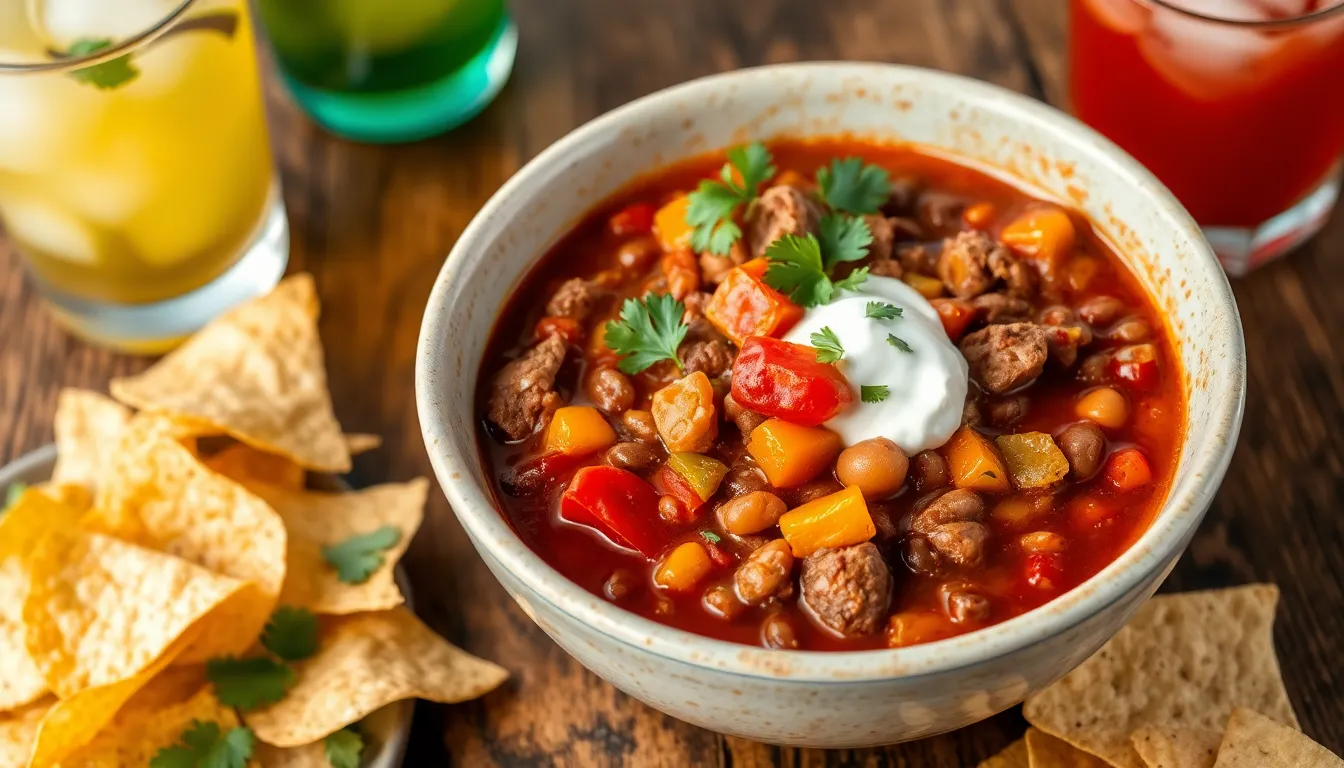
Moving beyond quick cooking methods, we find that beef cubes shine in slow-simmered chili where they develop incredible depth and tenderness. This hearty dinner option transforms simple beef chunks into a rich, satisfying meal that feeds families and impresses guests alike.
Balancing Heat Levels and Spice Blends
Controlling heat levels becomes essential when creating the perfect beef cube chili experience. We recommend starting with milder peppers like green bell peppers and Anaheim chiles, then gradually adding jalapenos for those who crave more intensity. Spice blends work best when we layer them thoughtfully, combining chili powder, cumin, smoked paprika, and oregano as our foundation.
Sweetness helps balance harsh chili notes, so we often add brown sugar or granulated sugar to round out aggressive spices. Worcestershire sauce contributes umami depth without overwhelming the dish, while a splash of beer adds complexity that enhances rather than masks the beef flavor. Chipotle pepper sauce offers smoky heat that complements the beef cubes beautifully, and we can adjust quantities based on our preferred spice tolerance.
Black pepper and additional seasonings should be added gradually, allowing us to taste and adjust as the chili simmers. Fire-roasted diced tomatoes combined with tomato paste create the ideal base that absorbs and distributes our spice blend evenly throughout the dish.
Adding Depth With Different Bean Varieties
Bean selection dramatically impacts both texture and nutritional value in our beef cube chili. We’ve found that combining red kidney beans with black beans creates an appealing visual contrast while offering different textures that complement the tender beef chunks. Chili beans bring pre-seasoned flavor that enhances our spice blend, while white beans add a creamy element that balances bolder ingredients.
Using multiple bean varieties in the same pot allows us to create more complex flavor dimensions. Red kidney beans hold their shape well during long cooking times, making them ideal for recipes that simmer for hours. Black beans contribute earthy undertones that pair exceptionally well with smoky spices like chipotle and smoked paprika.
White beans absorb surrounding flavors more readily than darker varieties, making them perfect for mellowing intense heat levels. We recommend using a combination of two to three bean types to maximize both visual appeal and flavor complexity in our beef cube chili creations.
Toppings That Complement Beef Cube Chili
Strategic toppings transform our beef cube chili from good to extraordinary by adding contrasting textures and cooling elements. Sour cream serves as our go-to heat reducer while contributing richness that complements the robust beef flavors. Shredded cheese options like Mexican blend, sharp cheddar, or Monterey Jack melt beautifully into the hot chili, creating creamy pockets throughout each serving.
Fresh chopped cilantro brings bright herbaceous notes that cut through the richness of beef and beans. We love how this simple garnish adds color and freshness to our hearty winter meals. Chopped olives provide briny contrast that enhances the overall flavor profile without competing with our carefully balanced spice blend.
Additional toppings we recommend include diced avocado for creaminess, chopped green onions for mild bite, and crushed tortilla chips for satisfying crunch. These elements allow each family member to customize their bowl according to personal preferences while maintaining the integrity of our perfectly seasoned beef cube chili base.
Comforting Beef Pot Pie With Flaky Crust

Nothing beats the satisfaction of a homemade beef pot pie, where tender beef cubes transform into a hearty dinner wrapped in golden pastry. This classic comfort food showcases how beef cubes can create restaurant-quality meals that warm both body and soul.
Preparing the Filling With Root Vegetables
Start by cutting your beef cubes into roughly 3/4-inch pieces and searing them in a hot pan to develop that deep, rich flavor we’re after. Chuck roast works exceptionally well here due to its marbling and how tender it becomes when slow-cooked.
Sauté your root vegetables next, combining carrots and potatoes with onions and mushrooms to create a hearty foundation. These vegetables absorb the savory gravy beautifully while adding texture and natural sweetness to every bite.
Deglaze the pan with red wine after removing the vegetables, scraping up those flavorful brown bits that’ll enhance your gravy. Add the beef back to the pot along with beef broth, tomato paste, Worcestershire sauce, and fresh thyme for an aromatic filling that simmers to perfection.
Finish the filling by stirring in peas and fresh parsley once everything’s tender, adding both color and a touch of brightness to balance the rich flavors.
Homemade vs. Store-Bought Pastry Options
Homemade pastry gives us complete control over ingredients and texture, resulting in that perfectly tender, flaky crust we all crave. But, this option requires more preparation time and baking skills to achieve consistent results.
Store-bought crusts offer incredible convenience without sacrificing quality, often yielding excellent flaky results with minimal effort. We can focus our energy on perfecting the beef filling while still delivering an impressive final dish.
Roll out your chosen crust to fit your baking dish, ensuring it covers the filling completely to trap all those delicious flavors and moisture inside.
Achieving the Perfect Golden Crust
Brush the top of your pastry with an egg wash made from beaten egg mixed with water to create that gorgeous golden, shiny finish. This simple step transforms your pot pie from homemade to bakery-quality appearance.
Cut small slits in the crust to allow steam to escape, preventing the pastry from becoming soggy while the filling bubbles underneath. These vents also create an attractive pattern that adds visual appeal to your finished dish.
Bake at 400°F for 30-40 minutes until the crust turns golden brown and you can see the filling bubbling through the vents. Let the pot pie rest for about 10 minutes after baking, allowing the filling to thicken slightly for easier serving and cleaner slices.
Mediterranean Beef Kabobs With Fresh Herbs
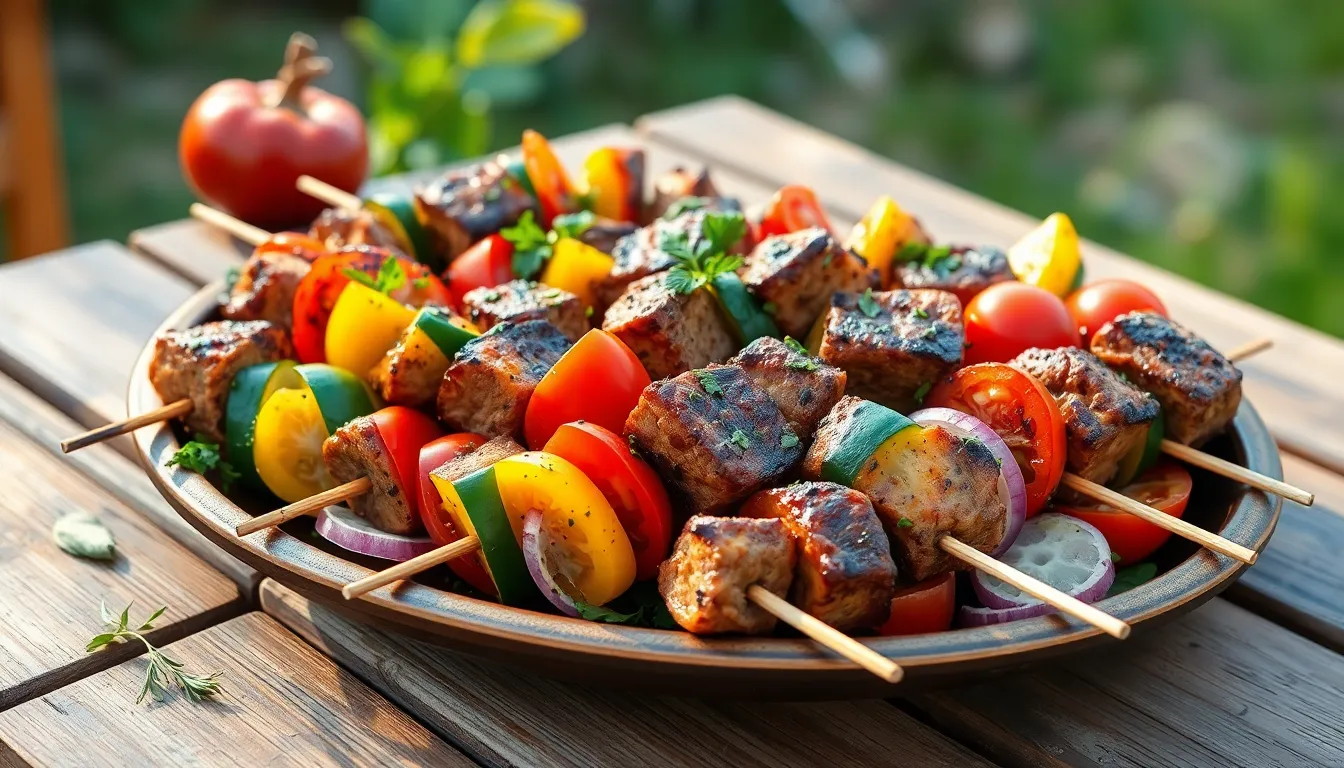
We’re elevating our beef cubes dinner game with vibrant Mediterranean kabobs that transform simple cubed beef into restaurant-quality skewers. These colorful kabobs feature 1¼-inch beef cubes marinated in olive oil, garlic, lemon juice, and aromatic Mediterranean spices like smoked paprika, cumin, and baharat for a bright, herbaceous flavor profile.
Marinating Techniques for Maximum Tenderness
Cutting our beef into uniform 3½ cm cubes ensures even cooking throughout each piece. We always pat the cubes dry with paper towels before marinating to promote better browning during grilling. Our marinade base combines olive oil with acidic components like lemon juice or vinegar, fresh garlic, and Mediterranean spices for maximum flavor penetration.
Marinating the beef for at least 1 to 2 hours or overnight in the refrigerator allows the flavors to infuse while tenderizing the meat naturally. We recommend salting the beef just before cooking rather than during marination to prevent drawing out moisture prematurely. Adding yogurt or a touch of baking soda to the marinade can further enhance tenderness, creating incredibly succulent beef cubes that rival any Mediterranean restaurant.
Vegetable Combinations for Colorful Skewers
Bell peppers in red, yellow, and green create a stunning rainbow effect when paired with our marinated beef cubes. We also love incorporating zucchini, cherry tomatoes, and red onion for their complementary flavors and vibrant colors. These vegetables not only add visual appeal but also provide a perfect balance to the savory beef.
Brushing our vegetables lightly with olive oil, garlic, and fresh herbs enhances their natural flavors while preventing them from drying out during grilling. Cutting vegetables to similar sizes as our beef cubes ensures everything cooks evenly on the same timeline. This strategic sizing creates perfectly balanced skewers where every bite delivers the ideal combination of tender beef and flavorful vegetables.
Grilling Tips for Even Cooking
Preheating our grill to medium-high heat and oiling the grates prevents sticking and ensures beautiful grill marks on our kabobs. We thread beef cubes and vegetables alternately on skewers to promote balanced cooking and heat distribution. Searing the skewers on all sides creates an appetizing char while locking in the natural juices.
Turning our kabobs frequently ensures even cooking on all surfaces without overcooking any single side. Using a meat thermometer helps us achieve the perfect doneness, aiming for 130-140°F internal temperature for medium-rare to medium beef cubes. Letting the kabobs rest for a few minutes after grilling allows the juices to redistribute, resulting in incredibly tender and flavorful Mediterranean beef cubes that make any dinner feel special.
Asian-Inspired Beef Stir-Fry With Crisp Vegetables
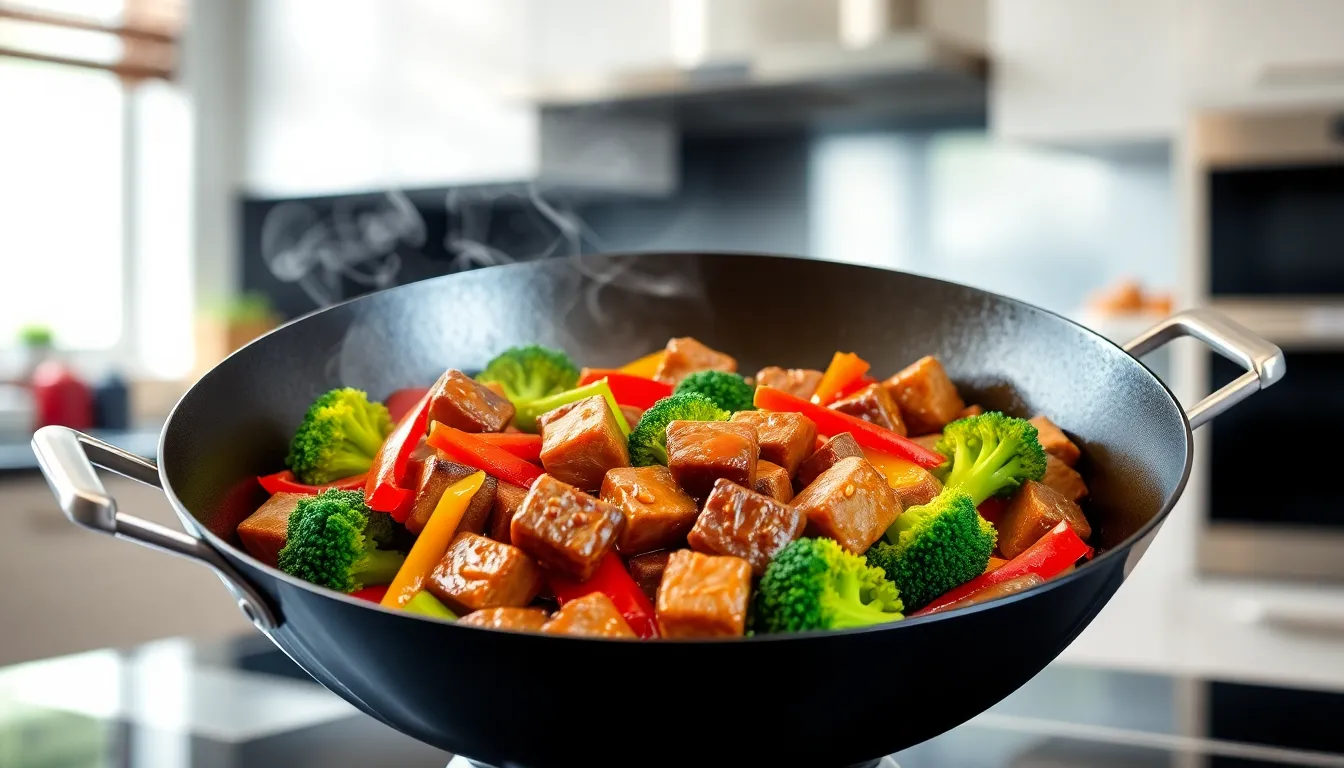
We’re taking our beef cube expertise to Asia with this vibrant stir-fry that balances tender meat with crisp vegetables in mere minutes. This technique showcases how beef cubes can shine in international cuisines beyond traditional Western comfort foods.
High-Heat Cooking Methods
Wok cooking transforms beef cubes into restaurant-quality stir-fry using extremely high heat and rapid movement. We recommend heating your wok or heavy skillet until it’s smoking hot before adding any oil or ingredients. Beef cubes should sear quickly for about 3 minutes, developing a beautiful caramelized exterior while maintaining tenderness inside.
Constant motion prevents burning and ensures even cooking throughout each cube. We’ve found that overcrowding the pan reduces heat and creates steam instead of the desired sear. Cook beef cubes in batches if necessary to maintain that crucial high temperature that gives authentic stir-fry its characteristic “wok hei” or breath of the wok flavor.
Sauce Combinations for Authentic Flavor
Marinating beef cubes creates the foundation for authentic Asian flavors that penetrate deep into the meat. We combine reduced sodium soy sauce with sesame oil for that essential umami base and nutty aroma. Mirin or dry sherry adds subtle sweetness and complexity that balances the saltiness perfectly.
Cornstarch serves double duty by tenderizing the beef and thickening the final sauce as it cooks. Fresh ginger and garlic provide the aromatic foundation that makes this dish irresistible. We recommend marinating the beef cubes for at least 15 minutes, though longer marination up to 2 hours develops even richer flavors.
Timing Vegetables for Perfect Texture
Vegetable timing separates amateur stir-fry from professional results, and we add them only after the beef achieves proper searing. Bell peppers, broccoli, Chinese broccoli, green beans, mushrooms, zucchini, and bok choy each require about 4 minutes of high-heat cooking to reach tender-crisp perfection.
Adding a splash of water during vegetable cooking creates steam that helps cook them quickly without losing vibrant color or essential nutrients. We start with harder vegetables like broccoli and green beans first, then add softer ones like mushrooms and bok choy in the final minutes. This strategic timing ensures every vegetable maintains its distinct texture and bright appearance while absorbing the savory sauce flavors.
Mexican Beef Tacos With Seasoned Cubes
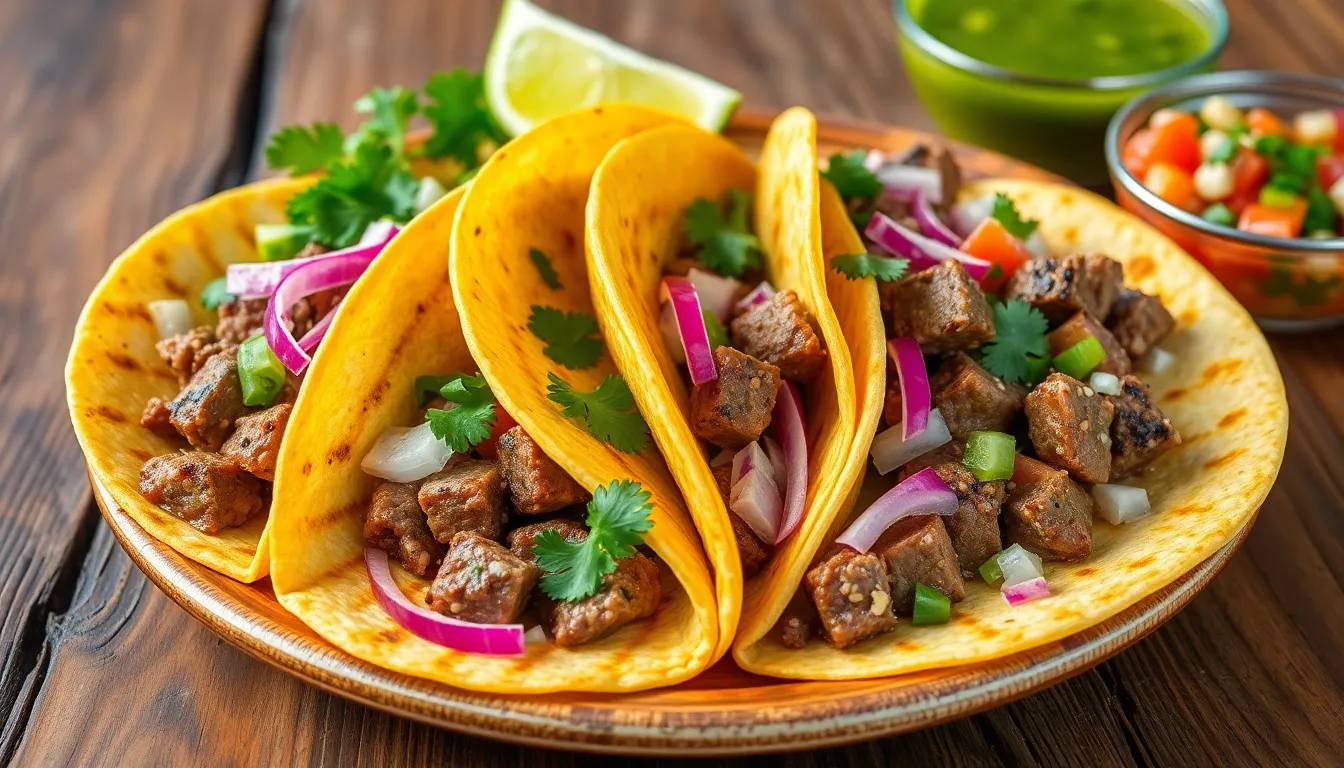
Building on our exploration of international beef cube dinners, we’re diving into the vibrant industry of Mexican cuisine where tender beef cubes transform into street-style taco perfection. These authentic flavors bring restaurant-quality Mexican food straight to your dinner table.
Traditional Spice Blends and Marinades
Creating authentic Mexican beef tacos starts with marinating your beef cubes in a traditional spice blend that delivers genuine street taco flavors. We recommend combining soy sauce, fresh lime juice, minced garlic, chili powder, ground cumin, and dried oregano with canola or olive oil for the perfect marinade base.
Marinating your beef cubes for 1 to 4 hours allows the meat to absorb these bold flavors completely. This combination creates a balance of savory, tangy, and mildly spicy notes that define authentic Mexican street tacos.
For additional seasoning after cooking, we suggest blending salt, pepper, cayenne, chili powder, dried cilantro, and cumin to provide warmth and depth. Adding fresh garlic and beef broth while simmering the meat creates moisture and richness that elevates the final dish.
Tortilla Options and Warming Techniques
Traditional small corn tortillas serve as the perfect foundation for our seasoned beef cube tacos, offering authentic texture and flavor. We prefer heating tortillas in a dry skillet or cast iron pan until they’re softened or develop slight char marks for added depth.
Adding a small amount of olive or avocado oil to the pan enhances both flavor and texture during the warming process. Folding tortillas over the seasoned beef and cheese mixture, then cooking on both sides until golden creates delicious taco shells with satisfying crunch.
Mini flour tortillas work well for street-style presentations, offering softness and pliability that complements the seasoned beef cubes perfectly. These alternatives provide flexibility while maintaining the authentic taco experience we’re aiming for.
Fresh Toppings and Salsa Pairings
Authentic toppings elevate our seasoned beef cube tacos and complement the rich meat flavors with fresh, bright elements. Diced red onion and chopped fresh cilantro provide essential freshness that balances the hearty beef cubes.
Fresh lime wedges offer the perfect acidic contrast to cut through the richness of our seasoned meat. Pico de gallo made with tomatoes, onions, cilantro, and lime adds texture and zing that transforms each bite.
Shredded Monterey Jack cheese contributes creamy richness, while sour cream or crema cools the palate when the beef carries extra heat. We recommend pairing these tacos with salsa verde for tangy contrast, roasted tomato salsa for smoky depth, or chipotle salsa for those who enjoy smoky heat.
This combination of marinated seasoned beef cubes, traditional spices, warmed tortillas, and fresh toppings creates authentic Mexican street taco flavors that rival your favorite taqueria.
Conclusion
We’ve discovered that beef cubes truly shine as the foundation for countless dinner possibilities. From comforting classics like beef stew and stroganoff to international favorites like Mediterranean kabobs and Mexican street tacos these versatile protein pieces adapt beautifully to any cuisine or cooking style.
The beauty of cooking with beef cubes lies in their ability to transform simple ingredients into restaurant-quality meals without requiring advanced culinary skills. Whether you’re slow-simmering a hearty chili or quick-searing a flavorful stir-fry these reliable cuts deliver consistent results every time.
With proper preparation techniques and the right flavor combinations beef cubes can elevate your weeknight dinners from ordinary to extraordinary. They’re budget-friendly time-efficient and incredibly satisfying – making them an essential ingredient for any home cook looking to create memorable meals that bring family and friends together around the dinner table.
Frequently Asked Questions
What are the best cuts of beef for making beef cubes?
Chuck roast and blade roast are ideal choices for beef cubes due to their rich marbling and tenderness when slow-cooked. For budget-friendly options, bottom round works well. For quicker cooking methods like stir-fries, ribeye and sirloin provide excellent flavor and texture.
How long should I marinate beef cubes for maximum flavor?
For optimal flavor penetration, marinate beef cubes for at least 30 minutes to 2 hours. For tougher cuts used in slow-cooking recipes, marinating overnight enhances tenderness and allows spices to fully develop. Always marinate in the refrigerator for food safety.
What’s the secret to tender beef cubes in stews and curries?
The key is low and slow cooking. Sear the beef cubes first to develop flavor, then simmer on low heat for 1.5-2 hours. This breaks down tough connective tissues, resulting in fork-tender meat that absorbs surrounding flavors beautifully.
Can I use beef cubes for quick weeknight dinners?
Absolutely! Beef cubes work perfectly for 30-minute meals like beef stroganoff or stir-fries. Choose tender cuts like sirloin or ribeye, cut them into uniform pieces, and use high-heat cooking methods for quick, flavorful results.
What vegetables pair best with beef cube dishes?
Root vegetables like carrots, potatoes, and onions are classic choices that add natural sweetness. For international dishes, bell peppers, mushrooms, and zucchini work excellently. The key is adding vegetables at the right time to maintain their texture and nutritional value.
How do I prevent beef cubes from becoming tough?
Avoid overcooking at high temperatures for extended periods. For tender cuts, cook quickly over high heat. For tougher cuts, use slow-cooking methods. Always cut against the grain and don’t skip the searing step, which locks in juices and flavor.
What’s the best way to season beef cubes for different cuisines?
For Mediterranean dishes, use herbs like oregano and thyme. Asian cuisines benefit from soy sauce, ginger, and garlic marinades. Mexican-style requires chili powder, cumin, and lime juice. Always season at least 15 minutes before cooking for better flavor absorption.
Are beef cubes budget-friendly compared to other cuts?
Yes, beef cubes are often more economical than premium steaks while still delivering excellent flavor and protein. Tougher cuts used for cubes become incredibly tender when cooked properly, making them a smart choice for feeding families without sacrificing taste.







